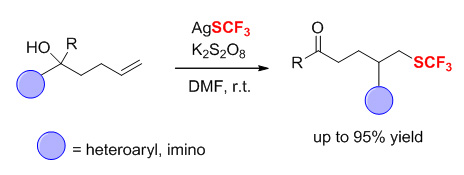| [1] (a) Leo, A.; Hansch, C.; Elkins, D. Chem. Rev. 1971, 71, 525;
(b) Hansch, C.; Leo, A.; Taft, R. W. Chem. Rev. 1991, 91, 165.
[2] (a) Leroux, F.; Jeschke, P.; Schlosser, M. Chem. Rev. 2005, 105, 827;
(b) Manteau, B.; Pazenok, S.; Vors, J.-P.; Leroux, F. R. J. Fluorine Chem. 2010, 131, 140.
[3] (a) Boiko, V. N. Beilstein J. Org. Chem. 2010, 6, 880;
(b) Landelle, G.; Panossian, A.; Pazenok, S.; Vors, J.-P.; Leroux, F. R. Beilstein J. Org. Chem. 2013, 9, 2476;
(c) Liang, T.; Neumann, C. N.; Ritter, T. Angew. Chem., Int. Ed. 2013, 52, 8214;
(d) Tlili, A.; Billard, T. Angew. Chem., Int. Ed. 2013, 52, 6818;
(e) Toulgoat, F.; Alazet, S.; Billard, T. Eur. J. Org. Chem. 2014, 2415;
(f) Xu, X.-H.; Matsuzaki, K.; Shibata, N. Chem. Rev. 2015, 115, 731;
(g) He, W.; Weng, Z. Prog. Chem. 2013, 25, 1071(in Chinese). (何伟明, 翁志强, 化学进展, 2013, 25, 1071);
(h) Xu, J.; Chen, P.; Ye, J.; Liu, G. Acta Chim. Sinica 2015, 73, 1294(in Chinese). (徐佳斌, 陈品红, 叶金星, 刘国生, 化学学报, 2015, 73, 1294);
(i) Zhang, K.; Xu, X.; Qing, F. Chin. J. Org. Chem. 2015, 35, 556(in Chinese). (张柯, 徐修华, 卿凤翎, 有机化学, 2015, 35, 556);
(j) Zhang, P.; Lv, L.; Shen, Q. Acta Chim. Sinica 2017, 75, 744(in Chinese). (张盼盼, 吕龙, 沈其龙, 化学学报, 2017, 75, 744);
(k) Hui, R.; Zhang, S.; Tan, Z.; Wu, X.; Feng, B. Chin. J. Org. Chem. 2017, 37, 3060(in Chinese). (惠人杰, 张士伟, 谭政, 吴小培, 冯柏年, 有机化学, 2017, 37, 3060);
(l) Zhao, X.; Li, T.; Tian, M.; Su, Z.; Wei, A.; Lu, K. Chin. J. Org. Chem. 2018, 38, 677(in Chinese). (赵霞, 李天娇, 田苗苗, 苏志扬, 魏奥琪, 芦逵, 有机化学, 2018, 38, 677).
[4] (a) Ferry, A.; Billard, T.; Langlois, B. R.; Bacqué, E. Angew. Chem., Int. Ed. 2009, 48, 8551;
(b) Zhang, P.; Li, M.; Xue, X.-S.; Xu, C.; Zhao, Q.; Liu, Y.; Wang, H.; Guo, Y.; Lu, L.; Shen, Q. J. Org. Chem. 2016, 81, 7486.
[5] Yin, F.; Wang, X.-S. Org. Lett. 2014, 16, 1128.
[6] Fuentes, N.; Kong, W.; Fernández-Sánchez, L.; Merino, E.; Nevado, C. J. Am. Chem. Soc. 2015, 137, 964.
[7] Honeker, R.; Garza-Sanchez, R. A.; Hopkinson, M. N.; Glorius, F. Chem. Eur. J. 2016, 22, 4395.
[8] Zhang, K.; Liu, J.-B.; Qing, F.-L. Chem. Commun. 2014, 50, 14157.
[9] Yang, T.; Lu, L.; Shen, Q. Chem. Commun. 2015, 51, 5479.
[10] (a) Pintauer, T.; Matyjaszewski, K. Chem. Soc. Rev. 2008, 37, 1087;
(b) Eckenhoff, W. T.; Pintauer, T. Catal. Rev. 2010, 52, 1;
(c) Cao, M.-Y.; Ren, X.; Lu, Z. Tetrahedron Lett. 2015, 56, 3732;
(d) Clark, A. J. Eur. J. Org. Chem. 2016, 2231;
(e) Kindt, S.; Heinrich, M. R. Synthesis 2016, 48, 1597.
[11] (a) Wu, Z.; Ren, R.; Zhu, C. Angew. Chem., Int. Ed. 2016, 55, 10821;
(b) Ji, M.; Wu, Z.; Yu, J.; Wan, X.; Zhu, C. Adv. Synth. Catal. 2017, 359, 1959;
(c) Ren, R.; Wu, Z.; Huan, L.; Zhu, C. Adv. Synth. Catal. 2017, 359, 3052;
(d) Ji, M.; Yu, J.; Zhu, C. Chem. Commun. 2018, 54, 6812.
[12] (a) Wu, Z.; Wang, D.; Liu, Y.; Huan, L.; Zhu, C. J. Am. Chem. Soc. 2017, 139, 1388;
(b) Wu, X.; Wang, M.; Huan, L.; Wang, D.; Wang, J.; Zhu, C. Angew. Chem., Int. Ed. 2018, 57, 1640;
(c) Wang, M.; Wu, Z.; Zhang, B.; Zhu, C. Org. Chem. Front. 2018, 5, 1896;
(d) Chen, D.; Wu, Z.; Yao, Y.; Zhu, C. Org. Chem. Front. 2018, 5, 2370;
(e) Zhang, H.; Wu, X.; Zhao, Q.; Zhu, C. Chem. Asian J. 2018, DOI:10.1002/asia.201800150.
[13] Yu, J.; Wang, D.; Xu, Y.; Wu, Z.; Zhu, C. Adv. Synth. Catal. 2018, 360, 744.
[14] Xu, Y.; Wu, Z.; Jiang, J.; Ke, Z.; Zhu, C. Angew. Chem., Int. Ed. 2017, 56, 4545.
[15] For selected reviews, see:(a) Wu, X.; Wu, S.; Zhu, C. Tetrahedron Lett. 2018, 59, 1328;
(b) Li, W.; Xu, W.; Xie, J.; Yu, S.; Zhu, C. Chem. Soc. Rev. 2018, 47, 654.
[16] (a) Thaharn, W.; Soorukram, D.; Kuhakarn, C.; Tuchinda, P.; Reutrakul, V.; Pohmakotr, M. Angew. Chem., Int. Ed. 2014, 53, 2212;
(b) Kong, W.; Casimiro, M.; Merino, E.; Nevado, C. J. Am. Chem. Soc. 2013, 135, 14480;
(c) Kong, W.; Merino; E;. Nevado, C. Angew. Chem., Int. Ed. 2014, 53, 5078;
(d) Fuentes, N.; Kong, W.; Fernandez-Sanchez, L.; Merino, E.; Nevado, C. J. Am. Chem. Soc. 2015, 137, 964;
(e) Kong, W.; Fuentes, N.; Garcia-Dominguez, A.; Merino, E.; Nevado, C. Angew. Chem., Int. Ed. 2015, 54, 2487;
(f) Zhou, T.; Luo, F.-X.; Yang, M.; Shi, Z.-J. J. Am. Chem. Soc. 2015, 137, 14586;
(g) Li, Z.-L.; Li, X.-H.; Wang, N.; Yang, N.-Y.; Liu, X.-Y. Angew. Chem., Int. Ed. 2016, 55, 15100;
(h) Li, L.; Li, Z.-L.; Wang, F.-L.; Guo, Z.; Cheng, Y.-F.; Wang, N.; Dong, X.-W.; Fang, C.; Liu, J.; Hou, C.; Tan, B.; Liu, X.-Y. Nat. Commun. 2016, 7, 13852;
(i) Li, L.; Gu, Q.-S.; Wang, N.; Song, P.; Li, Z.-L.; Li, X.-H.; Wang, F.-L.; Liu, X.-Y. Chem. Commun. 2017, 53, 4038;
(j) Wang, N.; Li, L.; Li, Z.-L.; Yang, N.-Y.; Guo, Z.; Zhang, H.-X.; Liu, X.-Y. Org. Lett. 2016, 18, 6026;
(k) Gu, L.; Gao, Y.; Ai, X.; He, C. Y.; Li, G.; Yuan, M. Chem. Commun. 2017, 53, 12946;
(l) Tang, X.; Studer, A. Chem. Sci. 2017, 8, 6888;
(m) Tang, X.; Studer, A. Angew. Chem., Int. Ed. 2018, 57, 814;
(n) Li, L.; Li, Z.-L.; Gu, Q.-S.; Wang, N.; Liu, X.-Y. Sci. Adv. 2017, 3, e1701487;
(o) Liu, J.; Li, W.; Xie, J.; Zhu, C. Org. Chem. Front. 2018, 5, 797;
(p) Zhao, Q.; Ji, X.-S.; Gao, Y.-Y.; Hao, W.-J.; Zhang, K.-Y.; Tu, S.-J.; Jiang, B. Org. Lett. 2018, 20, 3596;
(q) Wang, H.; Xu, Q.; Yu, S. Org. Chem. Front. 2018, 5, 2224;
(r) Wei, X.-J.; Noël, T. J. Org. Chem. 2018, DOI:10.1021/acs.joc.8b01624. |
